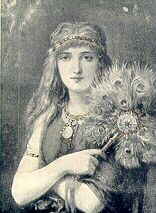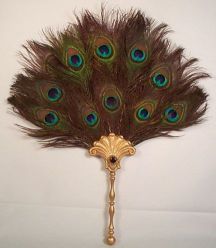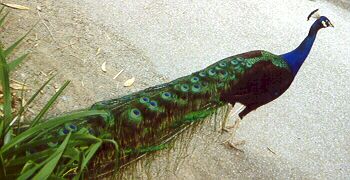PEACOCK'S PLEADINGS
The role of the peacock in the history of fans

fig.1
Post card approx. 1910
"Porteuse d'éventail"
"Vivat" Amst. No.5068
ORIGIN
The peacock (zoologically Pavo Cristatus) is held symbol
for mythologies, religions and ruling classes since millennia. The peacock's
origin lies in India and South-East Asia. It lives in thick underground
of the forests. Native people appreciate the peacock as it eats young
(poisonous) cobras. Its shrill croaking warns from tigers of which the
peacock itself is a victim (www.natur-lexikon.com).
The same source states that the peacock reached the Mediterranean already
4000 years ago, by ways of Arab trade routes. The male peacock's spreading
tail is in itself a "natural" folding fan. However, no literature
exists that would take this behaviour as the origin of the folding fan.
PACOCK
AND FAN IN ANCIENT TIMES
In India, peacock and fan entered an early symbiosis. Round fixed fans
were produced, simple fans with peacock feathers as decoration, or entirely
made of the splendid tail feathers. These fans are produced still nowadays,
in more or less the same way (Abb.1 und 2). Baro/Escoda (Library No.24)
tell us that a fan is first mentioned in writing in a Sanskrit-text
5000 B.C. A Sanskrit-drama dating from 200 A.C. describes a thunderstorm
(draft translation from German by mm):
"The peacocks suddenly fly upwards
when they hear the noisy clouds; they beat the air
as if with fans made of thousand jewels" (cit. Buss, Library No.54)
In China and Japan, the peacock is an ubiquitous motive on fans. Its feathers are used more rarely. In Egypt, the long ceremonial fans were most probably decorated with peacock feathers. These fans were royal symbols, symbols of power of the pharaohs. Only selected men, usually the sons of the pharaoh, were allowed to carry and handle these fans. (Buss, Library No.54).

fig. 2
Modern Indian fan

fig. 3
Tanagra-figure
with leaf fan from Beotia, approx. 300 B.C.
Kunsthistorisches Museum Vienna
In Greece, peacocks were the holy birds of Hera - Juno (goddess of home and marriage). They were shown for the first time at the temples of Hera in Samos. Greek mythology (with some variations) and Ovid's Metamorphoses explain the peacock's "eyes" on his tail feathers as follows: Hera-Juno, jealous of Io who was transformed into a white heifer by Zeus, ordered thousand-eyed Argus to watch over Io. Hermes, sent by Zeus to free Io, decapitates Argus. Juno collects all his eyes and applies them to her beloved birds, the peacocks.
Besides the short-handled leaf-fan as shown on Tanagra-figures ("Ripidion", see fig.3) and fire fans ("Ripis"), the Greek used also feather fans made of peacock-feathers. Such feather fans are mentioned in Euripides' "Orestes". Another story tells that young girls unhappily in love dedicated their peacock feather fans to Aphrodite, goddess of love (op.cit. Buss). Peacock feather fans were in fashion around 400 and 300 B.C.
Ancient Romans knew long-handled fans, often decorated with peacock feathers as depicted on Apulian vases, and small hand fans, so-called "tabellae". The latter is used in Ovid's third book of love when the lover fans the face of his beloved while she is asleep.

fig.5
P.P.
Rubens, Juno with Argus' head and peacocks
http://www.faculty.fairfield.edu/jmac
/sj/scientists/aguilon.htm

fig.4
Modern remake
of an old model
